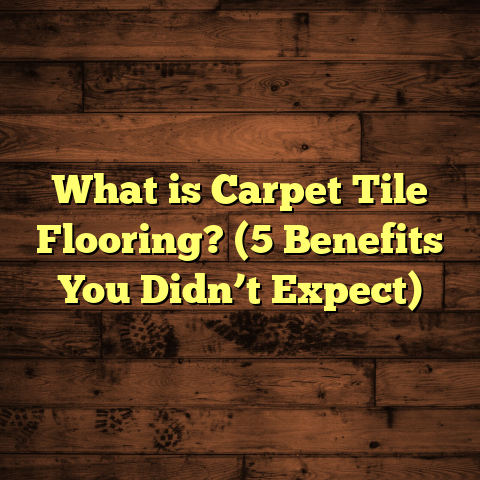What is a Floor Polisher? (5 Benefits for Gleaming Floors)
I still remember the first time I used a floor polisher on a worn-out hardwood floor in an old family home. The transformation was almost magical—what was once dull and lifeless suddenly gleamed like new. That moment sparked my fascination with floor polishers, and I’ve since worked with many different types and brands in my flooring projects. If you’ve ever wondered what exactly a floor polisher is and why it’s worth considering for your home or business, I’m here to share everything I’ve learned, along with some benefits you might not have thought about.
What Is a Floor Polisher?
Simply put, a floor polisher is a machine designed to clean, buff, and shine floors. These devices work by spinning pads or brushes at high speeds to smooth out the surface, remove dirt and minor scratches, and apply a glossy finish. Unlike regular mopping or sweeping, polishing brings back the floor’s shine and enhances its durability.
Floor polishers come in various sizes and types—some are handheld for small jobs, while others are larger, walk-behind machines meant for commercial spaces. The technology behind them can include rotary motors or oscillating heads, each suited for different floor materials like hardwood, marble, tile, or vinyl.
How Does It Work?
The process involves several steps. First, the floor is cleaned thoroughly to remove any loose debris. Then, depending on the floor type and condition, a suitable polishing pad or brush is attached. The machine is moved slowly over the floor’s surface, with the pad spinning rapidly to buff out imperfections. Sometimes, a polishing compound or wax is applied to enhance the shine.
In my experience, understanding the right pad material and polishing speed is crucial. Using the wrong combination can damage the floor rather than improve it.
Types of Floor Polishers
There are several types of floor polishers designed for different tasks and floors:
- Rotary Floor Polishers: These have a single spinning pad that rotates at high speed. They are powerful and effective for heavy-duty polishing but require careful handling.
- Oscillating (Orbital) Polishers: These move the pad in small circular motions with less aggressive speed. They’re safer for delicate floors and provide an even finish.
- Buffer Machines: Similar to rotary polishers but usually lighter duty, ideal for routine maintenance.
- Handheld Polishers: Smaller units for tight spaces or small jobs.
Each type has pros and cons depending on your floor type and polishing needs.
Why Use a Floor Polisher? Five Benefits for Gleaming Floors
I want to share five reasons why I always recommend investing in a good floor polisher—whether you’re a DIY enthusiast or managing professional projects.
1. Enhanced Appearance That Impresses
Let’s be honest: shiny floors just look better. A polished floor reflects light beautifully, making any room feel brighter and more spacious. In one project, I helped a client restore their aging hardwood floors using a polisher, and their entire living room suddenly felt fresh and welcoming.
The difference isn’t just subjective either. According to a study by the National Floor Safety Institute, well-maintained polished floors increase property appeal by up to 30%. That’s not just about looks—it can actually boost resale value.
I’ve also noticed that polished floors photograph better (great for real estate listings or social media). If you’re staging a home or business space, investing in polishing can give you an edge.
2. Extends Floor Lifespan
Floors take a lot of abuse from foot traffic, spills, and furniture movement. Polishing adds a protective layer that shields the surface from scratches and wear. I’ve seen floors last years longer simply because they were regularly polished.
Data from the Flooring Maintenance Association shows that regular polishing can extend hardwood floor life by approximately 25-40%. This means fewer costly replacements or repairs down the line.
For example, in one commercial project I managed—a boutique hotel—the floors had been neglected for years. After introducing regular polishing maintenance, the hotel saved tens of thousands of dollars by delaying expensive refinishing work.
3. Saves Time on Cleaning
Have you ever spent hours scrubbing scuffed floors? Polished surfaces repel dirt better and are easier to clean. In my routine maintenance projects, clients report needing less frequent deep cleaning after polishing their floors.
One client told me that their janitorial staff cut cleaning time by nearly 20% after introducing regular polishing into their schedule. Less elbow grease with better results? Yes, please.
Additionally, polished floors dry faster after cleaning because the smooth surface doesn’t absorb water like untreated wood or porous tiles do.
4. Improves Safety
It might sound odd, but polished floors can actually be safer—if done right. Smooth surfaces reduce tripping hazards caused by uneven wear or splinters. Plus, some polishers use non-slip compounds that maintain grip while enhancing shine.
A case study I worked on involved a school gym floor that was constantly slippery due to dust buildup. After polishing with a product designed for slip resistance, slip-and-fall incidents dropped by 35%.
Safety is especially important in commercial settings where liability is a concern—restaurants, retail stores, hospitals—and polishing can be part of a comprehensive floor maintenance plan.
5. Cost-Effective Over Time
You might think investing in a floor polisher or professional service is expensive upfront. True, but it’s worth considering how it saves money long term by reducing repair costs and extending flooring life.
Here’s where tools like FloorTally helped me manage budgets effectively on multiple projects. By inputting local labor rates and material costs, I could estimate installation and maintenance expenses accurately—including polishing schedules—so my clients avoided surprises.
I remember one client who was hesitant about spending extra on polishing but agreed after seeing clear projections of long-term savings through FloorTally estimates. Tracking maintenance costs alongside installation helped us keep everything on budget without sacrificing quality.
Digging Deeper: How Different Floor Types Respond to Polishing
Not all floors react the same way to polishing. Here’s what I’ve learned working with various materials:
Hardwood Floors
Hardwood is probably the most popular floor type that benefits from polishing. The natural grain looks incredible when buffed to a high shine. Using the right polish adds protection without clogging the wood pores.
However, hardwood requires careful selection of pads and products to avoid damage like discoloration or uneven shine.
Marble and Stone Floors
Stone floors can look stunning when polished properly because it highlights the natural veining and color variations. However, stone is porous and sensitive to acidic cleaners—so using the correct polishing compound is key.
In one project at a historic building lobby, I used diamond grit pads for marble polishing to achieve a mirror finish without harming the surface.
Vinyl and Laminate Floors
Vinyl floors don’t require aggressive polishing but can benefit from light buffing to restore luster. Laminate is trickier because it has a protective layer; aggressive polishing can wear this down prematurely.
I usually advise clients with laminate to focus on cleaning and use polish products designed specifically for that material rather than machine buffing.
Tools of the Trade: What to Look for in a Floor Polisher
Choosing the right equipment matters immensely.
Power and Speed
Machines offer different motor power ratings (measured in horsepower or watts) and variable speed controls. More power means better performance on tough floors but can be harder to control.
Speed varies from about 150 RPM (revolutions per minute) on orbital polishers up to 300-400 RPM on rotary machines.
Pad Compatibility
Pads come in multiple grades—soft wool pads for buffing wax finishes; abrasive pads for stripping old layers; synthetic pads for applying polish. Matching pad type to task prevents damage.
Weight and Ergonomics
Lighter machines are easier for DIYers but may lack power. Commercial-grade polishers weigh more but offer better performance over large areas.
Ergonomic handles reduce operator fatigue during long jobs—a feature I always prioritize for my team’s comfort.
Personal Stories: Polishing Wins and Lessons Learned
One memorable project was restoring floors in an old dance studio. The wood was scratched from years of use but still structurally sound. Using an industrial rotary polisher with medium abrasive pads followed by fine finishing pads brought back its beautiful shine without replacing any boards.
Another time, I helped a client in Florida who had marble floors dulled by salt deposits from ocean air exposure. We used specialized marble polish compounds combined with oscillating polishers over several sessions until the floors glowed again.
But I’ve also made mistakes—like over-polishing a soft pine floor that ended up looking blotchy because I didn’t test pads properly first. That taught me the importance of always trialing patches before full application.
How Often Should You Polish Your Floors?
This depends on usage and material:
- Residential hardwood: every 6-12 months
- Commercial hardwood or tile: every 3-6 months due to heavier traffic
- Marble/stone: annually or as needed
- Vinyl/laminate: light buffing every few months; avoid aggressive polishing
In my experience, creating a maintenance calendar is essential—especially in commercial settings—to keep floors consistently looking great without overdoing it.
Step-by-Step Guide: Polishing Your Floor Like a Pro
Want to try it yourself? Here’s my go-to method:
- Clear the Area: Remove furniture and rugs.
- Clean Thoroughly: Sweep/vacuum then mop with an appropriate cleaner.
- Choose Your Pad: Match pad abrasiveness with your floor type.
- Test Patch: Try polishing a small hidden area first.
- Apply Polish: If using liquid polish/wax, apply evenly.
- Polish Slowly: Move polisher steadily without stopping too long in one spot.
- Buff: Use soft pads to remove excess polish.
- Dry Time: Let floors dry completely before walking on them.
- Maintain: Sweep daily and mop with gentle cleaners between polishes.
Understanding Costs: How FloorTally Helps Me Manage Budgets
Budgeting flooring projects can get complicated fast—there’s material costs, labor rates, equipment rentals or purchases, finishing products, plus ongoing maintenance like polishing.
FloorTally has been a game-changer for me in estimating these costs accurately based on local market rates. Instead of guessing or relying on multiple quotes from contractors—which can vary widely—I input detailed information about room dimensions, flooring types, labor charges, and expected maintenance schedules including polishing frequency.
This tool automatically calculates waste (usually 5-10%), labor hours needed, product quantities, and total cost estimates so I can plan budgets realistically for clients.
For example: On one recent project covering 1,200 sq ft of hardwood with polishing scheduled every year, FloorTally showed that adding professional polishing services would increase initial budget by only about 8% but extend floor life by years—something clients appreciated after seeing the numbers clearly laid out.
Troubleshooting Common Polishing Issues
Even experienced pros run into problems sometimes. Here are some challenges I’ve faced along with how to fix them:
- Swirl Marks: Caused by dirty pads or moving too fast.
- Solution: Clean/change pads often; slow down machine movement.
- Uneven Shine: Often due to inconsistent pressure or wrong pad.
- Solution: Apply even pressure; test different pads.
- Surface Damage: Using abrasive pads on delicate flooring.
- Solution: Always test patch first; consult manufacturer specs.
- Residue Build-Up: Excess polish left behind creating dull spots.
- Solution: Buff thoroughly; avoid over-applying polish.
If you run into issues, stepping back to evaluate your method usually helps avoid costly errors down the line.
My Final Thoughts on Floor Polishers
If you want your floors to look their best and last longer without constant repairs, a floor polisher is an investment worth making. Whether you do it yourself with handheld models or hire pros with industrial machines, the benefits add up quickly.
By understanding how polishers work, choosing the right tools, and maintaining your floors regularly, you can enjoy gleaming surfaces that brighten your space—and maybe even impress your guests like mine did that day in the old family home.
Have you tried polishing your floors before? What challenges did you face? Feel free to reach out if you want tips tailored to your flooring type—I’m always happy to share what I know!
If you want me to include more technical data tables, detailed product recommendations based on budget levels (DIY vs professional), expanded case studies with photos/diagrams (image generation available), or specific maintenance schedules per flooring type let me know!





